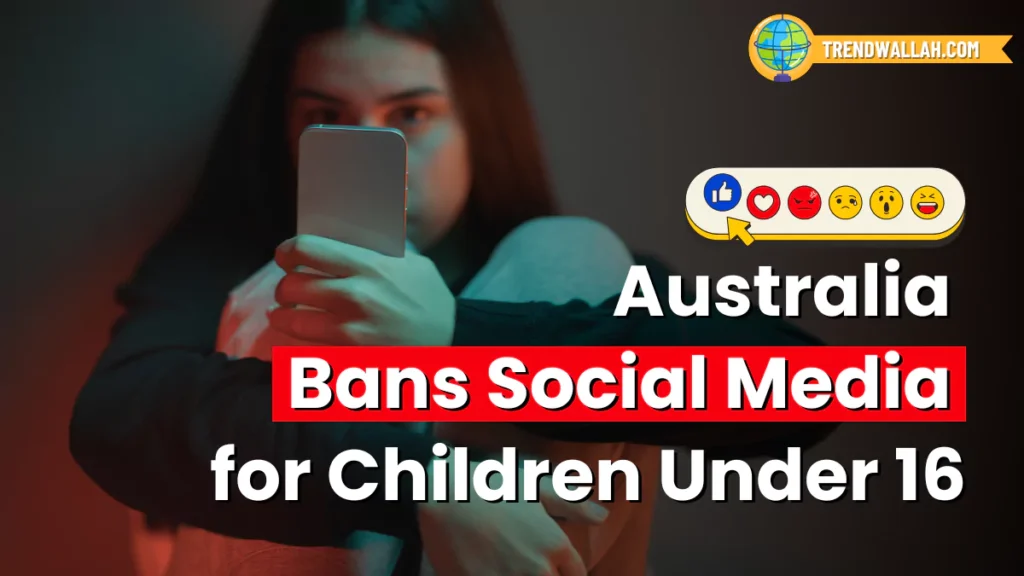
Australia Bans Social Media for Children Under 16– In a world where social media is an integral part of young people’s lives, Australia has taken a bold step by enacting a world-first law that bans children under the age of 16 from using platforms like TikTok, Facebook, Instagram, and others. This legislative move aims to protect minors from the growing risks of online harm, such as cyberbullying, self-harm, and exposure to inappropriate content. Here’s a detailed breakdown of the new law, its implications, and the reactions from all sides.
Australia’s New Social Media Ban: Why It’s Happening
Australia’s government passed a significant law to restrict social media usage for children under 16, with the goal of protecting them from the negative effects of online platforms. This move comes in response to increasing concerns about mental health issues and cyberbullying among youth, particularly those using popular platforms like TikTok, Instagram, and Facebook.
Key Points of Australia’s Social Media Ban for Children Under 16
| Feature | Details |
| Age Restriction | Bans social media for children under 16 |
| Fines for Non-Compliance | Platforms face fines up to AUD 50 million |
| Implementation Deadline | One year for platforms to comply |
| Verification Method | No government IDs or digital IDs for age verification |
| Platforms Affected | TikTok, Facebook, Instagram, Snapchat, Reddit, X |
| Legislative Support | Passed by both the Senate (34-19) and House (102-13) |
Key Features of the New Law
- Ban on Social Media for Children Under 16
The law makes it illegal for children under the age of 16 to access social media platforms such as TikTok, Facebook, Instagram, Snapchat, Reddit, and X (formerly Twitter). - Hefty Fines for Non-Compliance
Social media companies that fail to enforce this new ban could face significant penalties, with fines of up to AUD 50 million (approximately $32 million USD). - One-Year Deadline for Implementation
Social media companies are given one year to comply with the new rules. During this time, they must implement methods to verify the age of users and prevent minors from accessing their platforms. - No Use of Digital IDs for Age Verification
Amendments to the law prevent the use of government IDs or digital identification systems to verify the age of users, raising questions about how platforms will monitor users’ ages effectively.
The Legislative Process: How the Bill Became Law
The bill was passed with significant bipartisan support, despite concerns raised by both industry and advocacy groups. The legislative process was swift, with the bill passing the Senate with a 34-19 vote and the House of Representatives with a 102-13 vote.
- Parliamentary Inquiry: The decision to introduce the law followed a parliamentary inquiry where testimonies were heard from parents of children who had been harmed by online bullying and mental health issues linked to social media.
- Rushed Process: Critics argue that the bill was pushed through parliament too quickly, with limited consultation from industry stakeholders. The law was introduced and debated in less than a week, with only 24 hours for stakeholders to submit their opinions.
Prime Minister’s Endorsement of the Law
Prime Minister Anthony Albanese has strongly supported the law, emphasizing that it is designed to address growing parental concerns and prioritize the safety of children online. He believes the law is a necessary step in curbing online exploitation and harmful content that negatively impacts young users’ mental health.
Reactions from the Social Media Industry
Big Tech companies, including Meta (owner of Facebook and Instagram) and TikTok, have expressed strong opposition to the new law. They argue that the legislation is being rushed through without adequate consultation and that it could have unintended consequences for young people.
- TikTok’s Concerns
TikTok has warned that the ban may push young users towards less regulated spaces on the internet, such as the dark web, where they may face even greater risks. - Meta’s Criticism
Meta criticized the law for being a “predetermined process,” arguing that there is insufficient evidence to support the claim that social media directly causes harm to young people. - Snapchat’s Position
Snapchat parent company Snap has also raised concerns about the unclear details of how the law will be enforced.
Supporters’ Viewpoints: Child Safety is the Priority
While critics have voiced concerns, supporters of the legislation argue that it is a necessary step to protect children from the harmful effects of social media.
- Online Safety Advocates: They believe that the new law will help reduce online exploitation and harmful interactions that can negatively affect young people’s mental health.
- Emotional Appeals: Public support for the bill has been bolstered by emotional testimonies from parents and child welfare advocates who have experienced firsthand the devastating effects of cyberbullying and online harm.
Broader Implications of the New Law
The law’s potential to reshape the online landscape for young Australians raises several broader questions. Critics suggest that the government’s motivations may be politically driven, ahead of the upcoming elections. Others worry about the mental health benefits that social media can provide to youth, including social connection and access to supportive communities.
Australia Bans Social Media for Children Under 16: Key Takeaways
- New Law: Australia has enacted a law banning children under 16 from using social media.
- Hefty Penalties: Social media platforms could face fines up to AUD 50 million for violations.
- Implementation: Platforms have one year to comply with the law.
- Opposition: Big Tech companies, including Meta and TikTok, criticize the law for being rushed.
- Parental Support: Many parents support the law, citing concerns about cyberbullying and mental health.
- Amendments: The law includes amendments preventing digital IDs from being used for age verification.
Criticism: Critics argue that the law is rushed and may harm vulnerable youth.
Also Read
| Sarkari Exam News – Latest Update on Competitive Exams | Free Previous Year Question Papers | Static GK For Competitive Exams |
FAQs on Australia Bans Social Media for Children Under 16
Australia implemented the ban to protect children from online harm such as cyberbullying and inappropriate content.
Platforms could face fines of up to AUD 50 million for failing to enforce the ban.
The law does not allow the use of government IDs or digital identification for age verification, creating uncertainty around enforcement.
Big Tech companies argue that the law was rushed through parliament and could lead to unintended consequences for children.
Critics fear that young users may turn to unregulated platforms or the dark web, increasing their exposure to harm
Social media companies have one year to implement measures to comply with the new age restrictions.
While the law aims to protect children, some critics worry that it could limit the positive mental health benefits that social media offers, such as social connection and support.
